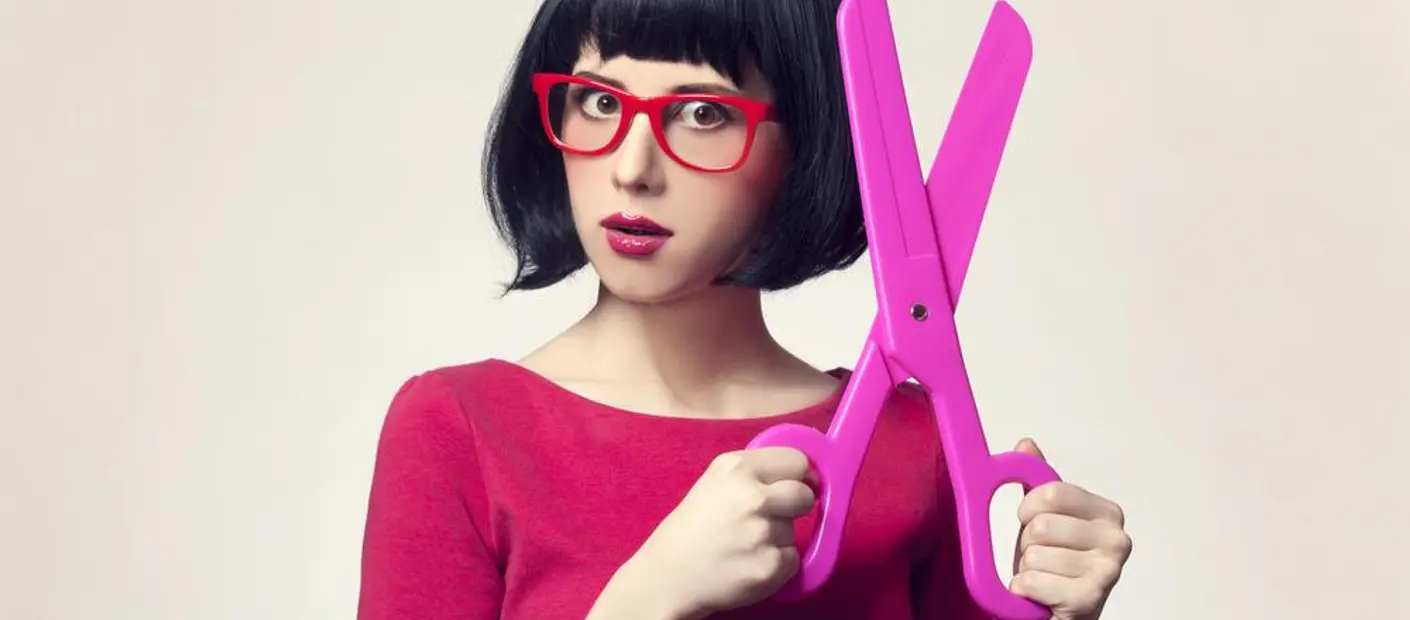
The Hairy Side of Women’s Hair Removal
by Madeleine Dow
Many ladies wonder what is “normal” when it comes to female body hair. If you look at Instagram, TV shows, or magazines for the answer, you’ll believe that women are meant to be 100% hairless below the neck. Wanting to be hairless and smooth is a personal choice, but it certainly isn’t necessary.
Body hair is natural. Some people are hairier than others, but everyone has it. In fact, hair generally grows pretty much everywhere on your body except the soles of your feet, the palms of your hands, and your lips.
Choosing to leave body hair doesn’t mean you have to forego all maintenance, constantly smell like patchouli, and live naked in the woods using fallen leaves as toilet paper. (Although, that’s always an option.) There are many ways to maintain body hair and even keep it odor-free!
What you do with your hair is your choice. Do what feels comfortable. Let’s talk about why women started removing hair, the pros and cons of hair removal, ways to remove hair, and causes for excess hair growth.
When Did Women Start Removing Hair?
In the 1920s, with the rise of sleeveless dresses, it became fashionable for women to remove underarm hair. Advertisements for depilatory (hair-removing) creams were mostly seasonal, running from spring to summer, which meant ladies probably didn’t care to remove hair when they were covered up in the wintertime. I feel that.
One particular advertisement from 1922 stated, “The fastidious woman to-day must have immaculate underarms if she is to be unembarrassed.” Advertisers in the 1920s wasted no time in essentially telling women, “You should be ashamed of your nasty, hairy pits!”
Along with the 1940s and 1950s came shorter dresses. These knee-length bad boys heralded in the fashion decree that leg hair must also be ELIMINATED.
As a NEET ad from 1945 stated: “Fashion has snipped sleeves to the shoulder, deepened the armholes. To wear these charming new sleeves, arm-pits must be smooth as your cheek, sweet as your breath.”
Advertisers played the line between fear-based ads, like the 1922 one, and more sensual ones, like the latter. Some ads were even surprisingly sexual considering the time period. Basically, the premises behind all hair removal ads were that you should be ashamed of hair, being hairless makes you sexy, and you will be an unwanted social outcast if you don’t shave.
It worked.
In a 1964 survey, 98 percent of American women between ages 15 and 44 removed some body hair.
As with any trend, there is a counterculture. Whether out of feminist rebellion against oppressive standards, medical reasons, personal belief, or just plain not caring, some ladies let it grow long and strong! There are benefits to both letting it go and letting it grow.
Let it Go or Let it Grow?
Hair removal as a lady is a very personal choice. As with every decision, there are pros and cons. If you want to be as smooth and hairless as a baby seal, you’ll be spending a long time in the tub and a fair amount of money. If you want to be hairy and free, you might get odd looks on the beach or in the office.
No matter what, you should choose to do what makes you feel comfortable and function better! So what are the upsides for each choice?
Reasons for Hair Removal
- Less hair means less surface area for bacteria to grow, which means less odor.
- Some people feel sexier with less hair or just like the aesthetic.
- Some people just like having smooth skin.
- If you’re a super competitive swimmer or biker, body hair can potentially slow you down.
Reasons for Keeping Hair
- Pubic hair provides some protection to private parts from bacteria.
- Pubic hair holds onto odors that may be attractive to potential mates. (As a society, we’re very obsessed with eliminating odors, but people got groovy for thousands of years before modern showers were invented.)
- You save so much time and money not dealing with shaving, waxing, plucking, etc.
Most people fall into an in-between state where they do a bit of each. For example, you might shave your legs and armpits, and wax your upper lip frequently, but leave your pubic hair in its full, bushy glory. Or you might have your pubic hair waxed into the shape of a heart and only shave your armpits and legs in the summer.
Whatever you do, from hairless to couldn’t-care-less, it’s up to you.
Ways to Maintain Hair
Shaving.
Shaving is the most popular form of hair removal. There are so many body parts you can shave: armpits, legs, upper lips, pubic area, happy trail, arms, toes, facial hair, and more. To prevent razor bumps and ingrown hairs, it’s best to use a nice, fresh razor on exfoliated skin. Learn more about how to treat and prevent razor bumps here.
You'll also want to find a shaving cream that doesn't have any irritating ingredients that rub your skin the wrong way.
Pro tip: Lume Triple Milled Soap is a great replacement for shaving cream, as well as for cleansing your whole body. It's deeply moisturizing, with a rich lather that's great for shaving. It's also free of irritating ingredients like sodium lauryl sulfate, parabens, phthalates, and dyes.
Trimming.
You can trim hair with an electric razor or you can use scissors. If you’re using an electric razor, a safety guard is a good idea when trimming your nethers. If you opt for scissors, please use scissors with rounded tips. You do not want sharp points near your lady parts!
Trimming is a great way to reduce hair in your pubic area without having to deal with razor burn or ingrown hairs. Trimming hair also reduces B.O. because there is less surface area on which bacteria can grow.
Plucking.
I think most of us are glad that plucking eyebrows into oblivion is no longer in fashion. (Tweezers were a formidable weapon in the early 2000s!) Plucking is a quick and eye-wateringly easy way to remove errant facial and eyebrow hairs, as well as that one rogue chin hair. The best time to pluck is after drying off from a warm shower. The warm water softens the hair follicle, making plucking less painful.
Threading.
Threading is great for removing facial hair and shaping eyebrows. Thread is twisted, held taught, and used to pluck short rows of hairs at a time. It’s generally a very precise and thorough way to remove hair. It only takes about 10 minutes and lasts for 2-5 weeks. You’ll want to leave this technique to the experts.
Depilatory Creams.
Not sure what this is? Think Nair. It’s a kind of cream you rub onto hairy areas, and it chemically dissolves hair. Sounds a little magical, but many people find it can be irritating to the skin. One upside is that it does not cause ingrown hairs like shaving commonly does. Depilatory creams were the only form of hair removal advertised to women before Gilette created the first razor for women in 1915.
Waxing.
The allure of waxing comes from smooth skin that lasts a lot longer than shaving. How long your wax lasts depends largely on genetics and how often you get waxed. Smooth skin after a wax lasts 2-4 weeks on average but can last up to 6 weeks if done repeatedly.
Regular waxing can damage hair follicles and make your hair finer over time. It does have its downsides, though - you’ll have to let the hair grow out a bit and waxing can be a painful process.
Laser Hair Removal.
This is a maintenance-free option, though it can be quite costly. A doctor or technician will use a laser with highly concentrated light that destroys hairs one by one. Many people see a significant reduction in hair growth after 4-7 sessions.
While companies advertise that the results are “permanent,” if you read the fine print you’ll find that “permanent” means a reduction in hair growth for six months after a series of treatments. It’s more of a long-term hair removal option, rather than permanent hair removal.
Laser hair removal has a very high upfront cost, anywhere from $200-$1200 per session, depending on the size of the area. Though, there are some at-home products you could try too. It works best on people with fair skin and dark, coarse hair.
Electrolysis.
Electrolysis is a method of hair removal where a professional (electrologist) destroys individual hair follicles with chemical or heat energy. Electrolysis is the ONLY method of hair removal that is recognized by the FDA and AMA as permanent. Electrolysis also has fewer risks and side effects than laser hair removal.
Electrolysis usually costs less per session than laser hair removal, but generally requires many more sessions. Most people require sessions about once a week until the follicles are permanently destroyed. Depending on how often you go and how coarse the hair is, it can take anywhere from 12 weeks to 2 years of sessions to work completely.
Let it Grow Long and Strong.
Proud to be au naturel? Rock on.
Be aware that full-grown body hair in the armpits and pubic area provides more surface area for bacteria to grow and produce odors. This just means you’ll have to do some extra scrubbing in the shower and use a bit more Lume Deodorant For Pits, Privates & Beyond if you want to prevent odor.
It’s Your Choice
Over their lifetimes, most people face unwanted hair that grows in inconvenient places, from unibrows to nipple hairs, from pubes to toe hairs.
How you choose to deal with it is completely up to you! Society may dictate what is fashionable, but you dictate what is reasonable. You have the power.
With Lume Deodorant and Lume Soap, you can smell good no matter what you decide. More hair will require a bit more scrubbing and deodorant to stay odor-free, while hair removal will require its own maintenance as well. As with most things in life, there are pros and cons to both.
Lume is skin loving deodorant that provides up to 72 hours of odor control and is safe to use anywhere on your external body! You can use it on your pits and privates, no matter the hair you’ve got. It’s also great for feet, underboobs, between the cheeks, tummy folds, and all your other crevices.
Lume was developed by an OBGYN, Dr. Shannon Klingman, as a solution for her patients with odor “below the belt,” and it turned out to be amazing for the rest of the body too! Lume stops bacteria from ingesting and digesting bodily fluids and producing foul odors. This means it prevents odor instead of just covering it up. Simply apply Lume where you need it after showering, and enjoy smelling great.
If you're looking to stretch showers out further or want odor protection with just a couple swipes of your hand, try Lume Deodorant Wipes. With all the same revolutionary odor-fighting active ingredients as Lume Deodorant, you can take a shower in your pocket anywhere you go with Lume Wipes.
So go on, rock your body, whether it’s hairy or not. It's your choice, after all!
When you add Lume to your hygiene routine, odor is optional.
Categories
Recent Articles
- The Art of Scent Layering With Lume
2025-09-24T20:51:28.831Z
- Your Pits Deserve Better: Why Lume is The Best Deodorant For Underarms
2025-08-08T14:01:16.861Z
- Bacteria On Our Skin: Friend Or Foe?
2025-07-17T19:53:50.363Z
- Why Lume's Premium Ingredients Deliver Quality & Real Value
2025-06-20T15:57:17.551Z
- Beat The Sweat This Summer
2025-04-30T14:14:55.836Z










